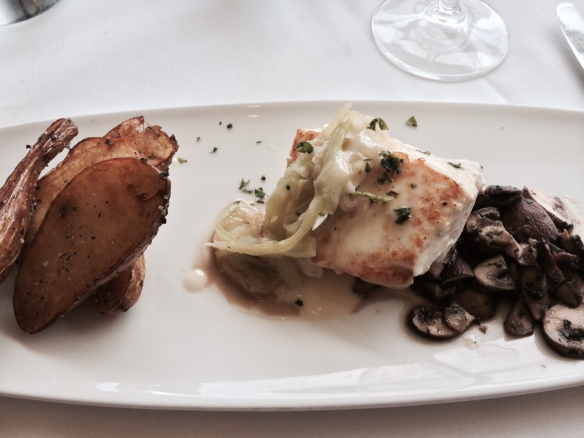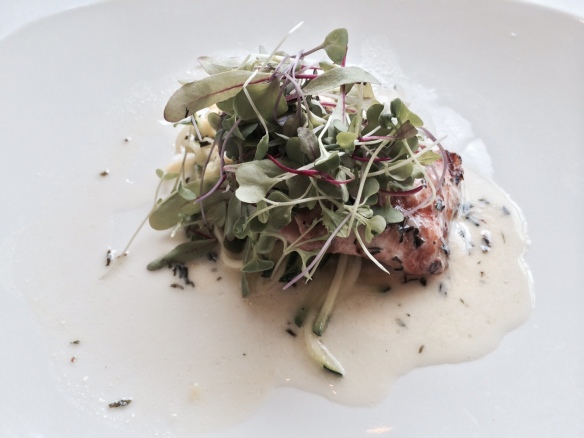New Orleans was treating me well. I had arrived the night before, driving up from South Florida, and my first stop, directly off of the interstate, was Pêche, a new destination – it opened about three months ago – in the Link Restaurant Group, the people behind Herbsaint and several other places. If you are in New Orleans and want some great seafood, take a drive to Magazine Street and sit for a while in Pêche.

Looking for Walker Percy: The courtyard of Creole Gardens, a bed and breakfast in New Orleans.
After oysters, smoked tuna dip, raw tuna with fennel, corn and tomato water, and excellent grouper collars, I drove the short distance to my inn, the Creole Gardens, and settled in for the evening, thinking of tomorrow’s meals. A comfortably shabby courtyard, complete with banana trees hanging with bunches of the fruit and a gurgling fountain, and a small but serviceable room, greeted me.
Up early the next morning, breakfast at the inn – grits, two eggs over easy and bacon. My mind wasn’t really on that food, though, because I was thinking about how long it would be before I could have lunch. You see, my plan was all about the po’ boy; specifically, one with the name “Peacemaker” made at Mahony’s, a restaurant I knew of and one of the meals recommended to me by John T. Edge when I asked him “If you could eat three meals in New Orleans now, where would you go?” (Pêche and Brigtsen’s were the other two.) I had read about the Peacemaker a few years ago, and that, along with John’s input, resulted in Mahony’s getting my business in a po’ boy-rich city.

This sign guides you to one fine po’ boy.
I made the right decision. Mahony’s is also on Magazine, in a non-descript house with a welcoming front porch that allows for outdoor dining. Wooden flooring, SEC football posters on the walls, condiments stored in six-pack containers. You place your order at the end of the bar, give your name, and wait for the goodness to come out of the kitchen. The Peacemaker is “market price,” owing to the fried oysters that are key to its deliciousness. It comes in large and small, and I ordered a small, knowing dinner was still on the agenda. Pickles and mayo, please, hold the lettuce and tomato. I took a seat, looking forward to the sandwich.
A few minutes later the cook delivered it to me, wrapped in white butcher paper. I opened it and inhaled, then slowly took the first bite. Perfect muffaletta with sesame seeds, slightly warm, the proper level of chewiness. (Mahony’s get its bread from the Leidenheimer Baking Company, which was founded in 1896 by George Leidenheimer, who was from Deidesheim, Germany, a city near where I lived in Germany.) I asked for a side of mayonnaise and settled in for a leisurely meal. The Abita Amber was a good complement.

The Peacemaker, closed view

Not the most visually appealing image, but once this is in your mouth you will be in heaven, guaranteed.
What we have: three or four fried oysters, cheddar cheese, and two slices of bacon. And we also have something approaching perfection. Oysters cooked with aplomb, crisp on the outside, warm and soft interiors. The bacon combined with the oysters to create a great taste. Even the small pickles added their element, turning these ingredients into something really special. My only thought other than “This is excellent” was that a better grade of cheese would make this po’ boy even better. The cheese resembled the Boar’s Head variety, and alone had an unremarkable taste. Perhaps a goat cheese, or a sharp cheddar. But, minor quibble aside, I would without hesitation enjoy a regular appointment at Mahony’s.
Oh yes, the name. Peacemaker. You might be wondering about that. I asked a waitress and she told me that she had heard it was because when musicians would stay out late at night playing and doing other things that happen at night they would stop by Mahony’s and take one home as a peace offering to their significant other, thereby keeping the peace, at least as long as that po’ boy lasted.
29.951066-90.071532
Like this:
Like Loading...
















Recent Comments